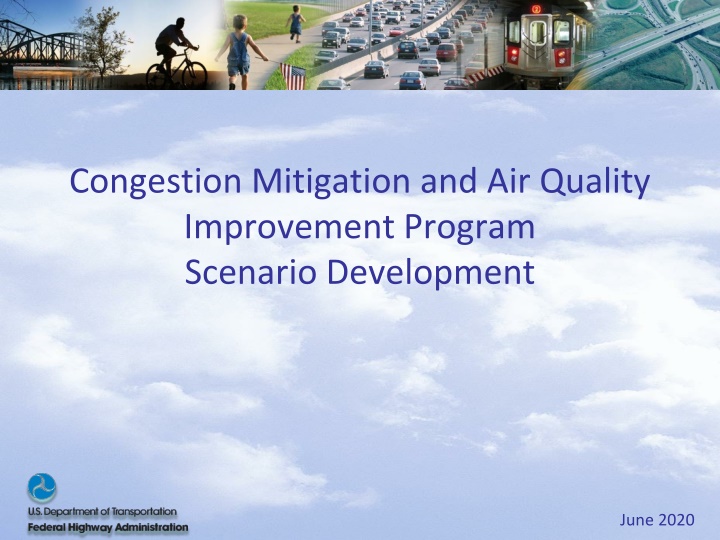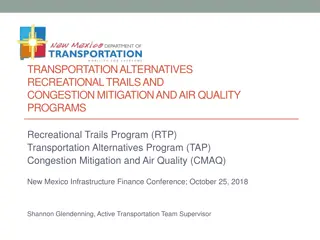
Improving Air Quality and Relieving Congestion Through CMAQ Program Scenario Development
"Explore the synergistic emissions benefits of CMAQ-funded projects, aiding in policy decisions. Learn about the CMAQ Program, its objectives, funding history, and scenario development for combined project benefits."
Download Presentation

Please find below an Image/Link to download the presentation.
The content on the website is provided AS IS for your information and personal use only. It may not be sold, licensed, or shared on other websites without obtaining consent from the author. If you encounter any issues during the download, it is possible that the publisher has removed the file from their server.
You are allowed to download the files provided on this website for personal or commercial use, subject to the condition that they are used lawfully. All files are the property of their respective owners.
The content on the website is provided AS IS for your information and personal use only. It may not be sold, licensed, or shared on other websites without obtaining consent from the author.
E N D
Presentation Transcript
Congestion Mitigation and Air Quality Improvement Program Scenario Development June 2020
Project Objectives Examine the potential for synergistic emissions benefits for groups of projects funded by the CMAQ program: Provide information to help inform State and MPO policy and investment decisions This report makes no claim regarding the eligibility of any project example under the CMAQ Program. States and MPOs should consult with their FHWA Division office with any questions regarding project eligibility. Provide information on opportunities and challenges when combining projects into synergistic groups Support potential programmatic assessments of CMAQ projects Lay framework for testing suites of CMAQ projects for combined benefits 2
Introduction to the CMAQ Program Congestion Mitigation and Air Quality Improvement (CMAQ) Program Established in 1991 under ISTEA (23 U.S.C. Section 149) Established to help fund transportation projects or programs that contribute to the attainment or maintenance of the National Ambient Air Quality Standards 3
Introduction to the CMAQ Program (continued) Reauthorized in all subsequent transportation reauthorization Acts, most recently the FAST Act Annual funding level at about $2.3 - $2.5 billion (FY 2016-2020) Since 1992 has provided more than $38 billion to fund over 40,000 transportation related environmental projects for State DOTs, Metropolitan Planning Organizations, and other sponsors throughout the U.S. 4
CMAQ Scenario Development Report Outline Executive Summary 1. Introduction 2. Benefits, Challenges, and Solutions for Leveraging Synergies Among CMAQ Projects 3. Summary of CMAQ Project Types to Inform Potential Scenario Groupings 4. Strategy Groupings 5. Conclusion Appendices 5
Project Approach Create scenarios with synergistic CMAQ project types Review existing resources for information on synergies Describe potential synergies among project types Create sample project menus for each scenario Identify types of CMAQ projects 6
CMAQ Project Types Diesel Engine Retrofits/ Advanced Truck Technology Idle Reduction Congestion Reduction and Traffic Flow Freight/Intermodal Transportation Control Measures Transit Improvements Bike and Ped Facilities and Programs Travel Demand Management Public Education and Outreach Activities Transportation Management Associations Carpooling and Vanpooling Carsharing Extreme Low-Temperature Cold Start Training Inspection and Maintenance Programs Alternative Fuels and Vehicles 7 Source: FHWA CMAQ Interim Program Guidance, 2013.
Current Practice Little information on potential synergies Most current evaluation methods focused on individual project benefits Very few examples of MPOs or States explicitly considering synergies in project prioritization/programming In a few cases, multi-phase projects are evaluated as one 8
Examples of Synergistic Benefits Programs to purchase CLEAN FUEL TRANSIT VEHICLES may achieve economies of scale in purchasing if implemented across multiple agencies, resulting in lower cost per unit of emissions reduced. The effectiveness of projects to IMPROVE PUBLIC TRANSIT SERVICE or provide PEDESTRIAN AND BICYCLE PATHS could be increased if PUBLIC EDUCATION AND OUTREACH PROGRAMS were in place to provide information to people about travel alternatives. Investments to support INTERMODAL FREIGHT MOVEMENT might be more effective at reducing emissions if combined WITH IDLE REDUCTION, DIESEL RETROFIT, or other emission- reducing technologies on equipment that will see increased use. The effects of BICYCLE INVESTMENTS might increase if multiple projects are completed that contribute to a connected network of bicycle facilities. 9
Challenges and Solutions in Leveraging Synergies Understanding synergies and combining wide range of project types Reasonable and feasibility issues Geographic distribution Multiple pollutants Varying size (e.g., population) and geographic context of States and MPOs implementing CMAQ projects 10
Potential Synergies Among Project Types could have synergies with a project of this type: Bike and Ped Facilities and Programs TDM Diesel Retrofit and Advanced Truck Tech Congestion Reduction and Traffic Flow Public Education and Outreach Alt. Fuels and Vehicles Transit Improve- ments Carpooling and Vanpooling Extreme Low-Temp. Cold Start Idle Freight/ Intermodal Car- sharing I&M Reduction TMAs Training Programs Diesel Engine Retrofits/ Advanced Truck Tech Idle Reduction Congestion Reduction and Traffic Flow Freight/Intermodal Transit Improvements A project of this type Bike and Ped Facilities and Programs TDM Public Education and Outreach Activities TMAs Carpooling and Vanpooling Carsharing Extreme Low- Temperature Cold Start Training I&M Programs Alternative Fuels and Vehicles 11
Synergistic Scenarios and CMAQ Project Types Conges- tion Traffic Flow Low- Temp. Cold Start Training Idle Reduc- tion Bike & Ped Alt. Fuels and Vehicles Diesel Retrofit Freight/ Intermodal Transit Public Education TMAs Carpool Vanpool Car- sharing I&M TDM Programs Sample Scenario/Goal 1. Expand Commute Options 2. Increase Active Transportation 3. Provide Clean Public Transportation 4. Reduce Emissions and Congestion from Freight 5. Reduce Congestion in Urban Corridor/Activity Center 6. Manage Congestion on Regional/Statewide Level 7. Reduce PM and NOx Emissions Heavy Duty Vehicle Focus 8. Prevent NAAQS Ozone Exceedances 9. Reduce Emissions in Rural Areas/ Small Communities
Examples of Synergistic Benefits: Expand Commute Options Scenario Helpful CMAQ Project Types TDM, transit improvements, carpooling and vanpooling, public education and outreach, TMAs, training Potential Synergistic Benefits More multimodal options can increase likelihood of non-SOV use by providing travelers with multiple options, such as carpooling to work, with the option of taking transit home if the carpool is missed Public education and institutional work (TMAs) can support other strategies Examples Regionally coordinated TDM projects and programs that include formation of TMAs, enhanced transit service to activity centers, a regional vanpooling and carpool matching program and incentives, and public education activities Addresses Multiple Pollutants Most/all pollutants affected in same proportion through VMT reductions Possible exceptions for increased transit Geographic Suitability/Area Types Most relevant in urban and suburban areas with more density and travel options Statewide programs can support strategy implementation across the State 14
Sample Project Menu: Expand Commute Options (Metropolitan) Sample Projects CMAQ Project Type Regional TDM program support (staffing for regional coordinator) TDM Regional guaranteed ride home program TDM Regional telework resource center TDM Assistance to administer employer-based cash-out pilot TDM Redesignate general purpose to HOV lane in high-transit corridors serving downtown TCMs Implement statewide trip reduction ordinance TCMs Pilot reverse-commute urban suburban shuttle program Transit Improvements Regional carpool and vanpool matching program Carpooling and Vanpooling Vanpool capital subsidy Carpooling and Vanpooling Regional TDM outreach and education program Public Education Staffing for TMAs serving downtown and suburban activity centers TMAs Training for regional TDM and TMA staff Training 15
Examples of Synergistic Benefits: Reduce PM and NOx Heavy Duty Vehicle Focus Helpful CMAQ Project Types Diesel retrofit/truck technology, idle reduction, public education and outreach, training, I&M programs Potential Synergistic Benefits Coordination of purchasing Growth of institutional knowledge on the most effective technologies for specific use cases and operating conditions Examples Diesel retrofit, idle reduction, and heavy-duty alternative fuel projects that meet local PM or NOx cost effectiveness thresholds for equipment used in heavily populated areas Addresses Multiple Pollutants May reduce all pollutants, but targeted especially to PM and/or NOx reduction through technology and heavy-duty vehicle focus Geographic Suitability/Area Types May be applicable at any geographic scale, but especially for PM nonattainment areas, and in vicinity of communities where health concerns are expressed 16
Sample Project Menu: Reduce PM and NOx Heavy-Duty Vehicle Focus (State) Sample Projects CMAQ Project Type Diesel retrofit assistance: Approved emission reducing retrofit technology, prioritized towards drayage and other short-haul trucks serving urban areas Diesel Engine Retrofits and Other Advanced Truck Technologies Purchase of a hybrid electric switcher locomotive for a rail yard near a densely populated community Idle Reduction Clean Air Assistance Program: staff and technical resources to help heavy- duty vehicle fleet managers and individual owner/operators match appropriate clean technology with their vehicles and operating requirements Public Education and Outreach Activities Training for Clean Air Assistance and heavy-duty I&M program staff Training Heavy-duty I&M program: roadside enforcement in densely populated + high truck traffic areas to identify high-emitting vehicles and target these vehicles for repair I&M Programs 17
Conclusions CMAQ projects may have synergistic effects that increase emissions and/or congestion relief benefits Little existing consideration of synergistic effects This project proposes groupings of CMAQ projects that are likely to provide synergies with respect to congestion and/or emissions reduction Further testing needed to measure extent to which synergies might be achieved in practice 18
For Further Information FHWA (2020). Congestion Mitigation and Air Quality Improvement Program Scenario Development. FHWA CMAQ Program Resources https://www.fhwa.dot.gov/environment/air_qua lity/cmaq/ 19

